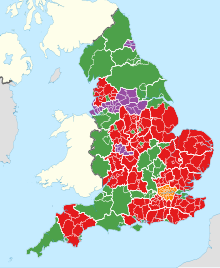
Back Distritos d'Inglaterra AST Distrigoù Bro-Saoz Breton Districtes d'Anglaterra Catalan Distrikty v Anglii Czech Ardaloedd awdurdod lleol yn Lloegr Welsh District (England) Danish Distritos de Inglaterra Spanish Ringkond (Inglismaa) Estonian Englannin hallintopiirit Finnish District d'Angleterre French
| District | |
|---|---|
| |
 | |
| Category | Administrative district |
| Location | England |
| Found in | Counties |
| Created by | Local Government Act 1972 London Government Act 1963 |
| Created |
|
| Number | 296 (as of 2021) |
| Possible types |
|
| Possible status | |
| Populations | 2,300 – 1.1 million |
| Areas | 3 – 5,013 km2 (1 – 1,936 sq mi) |
The districts of England (also known as local authority districts or local government districts to distinguish from unofficial city districts) are a level of subnational division of England used for the purposes of local government.[1] As the structure of local government in England is not uniform, there are currently four principal types of district-level subdivision. There are a total of 296 districts made up of 36 metropolitan boroughs, 32 London boroughs, 164 two-tier non-metropolitan districts and 62 unitary authorities, as well as the City of London and the Isles of Scilly which are also districts, but do not correspond to any of these other categories. Some districts are styled as cities, boroughs or royal boroughs; these are purely honorific titles and do not alter the status of the district or the powers of their councils. All boroughs and cities (and a few districts) are led by a mayor who in most cases is a ceremonial figure elected by the district council, but—after local government reform—is occasionally a directly elected mayor who makes most of the policy decisions instead of the council.
- ^ "Local Authority Districts (2015) to Counties (2015) Eng lookup". ONS. Archived from the original on 16 September 2016. Retrieved 2 September 2016.
© MMXXIII Rich X Search. We shall prevail. All rights reserved. Rich X Search